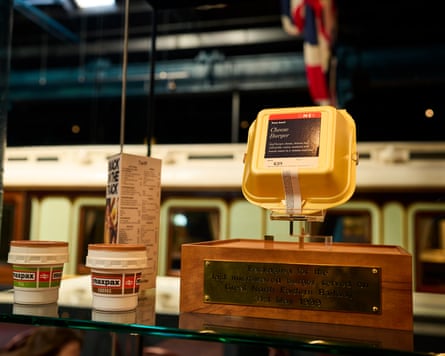There is Queen Victoria’s funeral wreath, a station ticket kiosk allegedly used by Rod Stewart and then an object so important it comes on its own plinth: the last ever microwave-burger box before the introduction of “deli-style” meals on GNER trains.
“I can remember having a cheeseburger on the train coming down from Aberdeen to London in the 1990s,” said Andrew McLean with fondness.
McLean is the head curator at the National Railway Museum in York, and someone who believes British railway catering more generally has an unfair reputation.
“People have this idea that it was a terrible thing, but actually it was some of the best catering you could get in this country,” he said. “In the 1970s the dining car breakfast was one of the best you could get anywhere.”

McLean is speaking as he shows the Guardian around the museum’s newly refurbished Station Hall space, a former goods station that since 1990 has been home to the museum’s collection of six royal carriages.
The Station Hall has been closed for more than two years for an £11m refurbishment, including an essential new roof.
“It had been leaking since the 1870s,” said McLean. “Sometimes if it had been raining we would have buckets catching water. Making this building wind and watertight for the first time is transformational for us.”
The public reopening on Friday coincides with the museum’s 50th anniversary celebrations this weekend, a “monumental milestone” for what was the first national museum to open outside London, said its director, Craig Bentley.
The idea in the Station Hall is to celebrate the station and the universal stories it can shine light on.

“We want to appreciate and celebrate the station,” said curator Karen Baker. “We’ve all got experiences of the station, the excitement when you go on holiday, the boredom of having to wait after your train has been cancelled.
“What we hope for is for people to appreciate the station in all its guises – the good, the bad … whatever. It is a real hub of humanity and as a consequence there are so many great stories.”
The microwave-burger box was formally donated to the museum, tongue in cheek, by Great North Eastern Railway in 1999.
Next to it in the display case are the then-revolutionary Maxpax coffee and teacups introduced by British Rail in 1979, designed to prevent burned fingers. Below is a fabulous silver coffee pot in the shape of an early locomotive, which in the 19th century had pride of place in Swindon station’s refreshment rooms.
Isambard Kingdom Brunel, however, described the coffee it served as tasting like “bad roasted corn”.
Elsewhere in the hall is an enormous wreath that was on the front of the locomotive that hauled Victoria’s funeral train in 1901. It has been in storage for more than 30 years and the challenging restoration involved opening a case that had been sealed for more than 100 years, curators said.
after newsletter promotion

There is also a newly restored WH Smith bookstall first installed at Waterloo station in London in 1921, and a passimeter – a ticket kiosk – from Winchmore Hill station.
“I was lucky enough to meet a chap who worked in this box,” said McLean. “One regular passenger back then was Rod Stewart. He used to buy his tickets from this very ticket office.”

Photographic displays include prints from a collection of pictures by Howard Grey showing tired, pensive Windrush migrants arriving at Waterloo in 1962.
The objects and rail vehicles on display tell very human stories, but also animal ones, including that of an Airedale terrier called Laddie who has always been a favourite for museum visitors.

When alive, Laddie walked up and down Waterloo station for seven years with a box strapped to his back, collecting money for Southern Railway servants’ orphanage.
After he died it was felt only right to stuff him and put him in a glass case to continue collecting money at Wimbledon station.
There are slots in his display case for visitors to drop in spare change. It’s what he would have wanted, said McLean. “He has been collecting since 1948, and if you have any coins, he still is.”

 3 months ago
42
3 months ago
42

















































